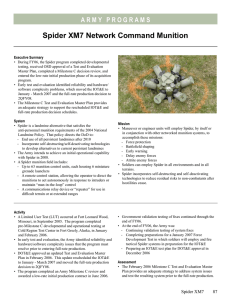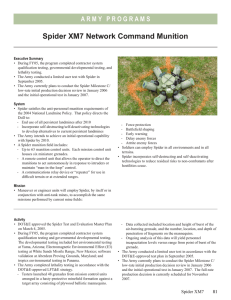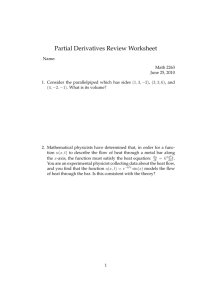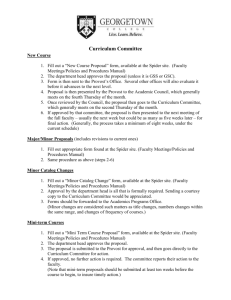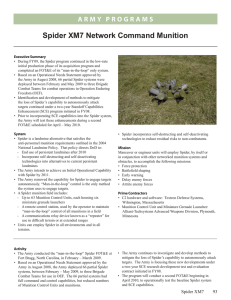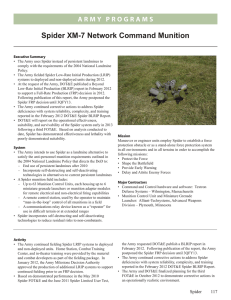Spider XM7 Network Command Munition
advertisement
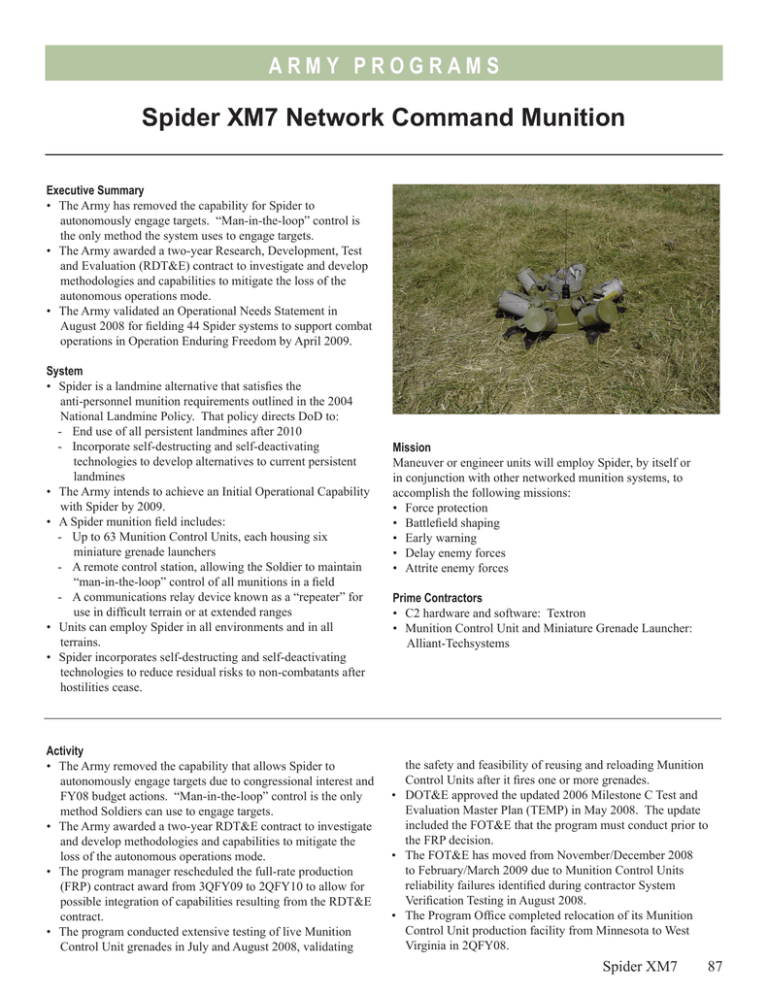
A r my P RO G R A M S Spider XM7 Network Command Munition Executive Summary • The Army has removed the capability for Spider to autonomously engage targets. “Man-in-the-loop” control is the only method the system uses to engage targets. • The Army awarded a two-year Research, Development, Test and Evaluation (RDT&E) contract to investigate and develop methodologies and capabilities to mitigate the loss of the autonomous operations mode. • The Army validated an Operational Needs Statement in August 2008 for fielding 44 Spider systems to support combat operations in Operation Enduring Freedom by April 2009. System • Spider is a landmine alternative that satisfies the anti‑personnel munition requirements outlined in the 2004 National Landmine Policy. That policy directs DoD to: - End use of all persistent landmines after 2010 - Incorporate self-destructing and self-deactivating technologies to develop alternatives to current persistent landmines • The Army intends to achieve an Initial Operational Capability with Spider by 2009. • A Spider munition field includes: - Up to 63 Munition Control Units, each housing six miniature grenade launchers - A remote control station, allowing the Soldier to maintain “man-in-the-loop” control of all munitions in a field - A communications relay device known as a “repeater” for use in difficult terrain or at extended ranges • Units can employ Spider in all environments and in all terrains. • Spider incorporates self-destructing and self-deactivating technologies to reduce residual risks to non-combatants after hostilities cease. Activity • The Army removed the capability that allows Spider to autonomously engage targets due to congressional interest and FY08 budget actions. “Man-in-the-loop” control is the only method Soldiers can use to engage targets. • The Army awarded a two-year RDT&E contract to investigate and develop methodologies and capabilities to mitigate the loss of the autonomous operations mode. • The program manager rescheduled the full-rate production (FRP) contract award from 3QFY09 to 2QFY10 to allow for possible integration of capabilities resulting from the RDT&E contract. • The program conducted extensive testing of live Munition Control Unit grenades in July and August 2008, validating Mission Maneuver or engineer units will employ Spider, by itself or in conjunction with other networked munition systems, to accomplish the following missions: • Force protection • Battlefield shaping • Early warning • Delay enemy forces • Attrite enemy forces Prime Contractors • C2 hardware and software: Textron • Munition Control Unit and Miniature Grenade Launcher: Alliant-Techsystems the safety and feasibility of reusing and reloading Munition Control Units after it fires one or more grenades. • DOT&E approved the updated 2006 Milestone C Test and Evaluation Master Plan (TEMP) in May 2008. The update included the FOT&E that the program must conduct prior to the FRP decision. • The FOT&E has moved from November/December 2008 to February/March 2009 due to Munition Control Units reliability failures identified during contractor System Verification Testing in August 2008. • The Program Office completed relocation of its Munition Control Unit production facility from Minnesota to West Virginia in 2QFY08. Spider XM7 87 A r my P RO G R A M S • The program manager awarded a low-rate initial production modification contract to extend low-rate initial production through 2QFY10. • The Joint Requirements Oversight Council approved the modification of Spider’s Combat Casualty Key Performance Parameter in May 2008 to reflect capabilities achievable with only the “man-in-the-loop” operational mode. • The Army validated an Operational Needs Statement in August 2008, for fielding 44 Spider systems to support combat operations in Operation Enduring Freedom by April 2009. • The program manager validated Spider interoperability with friendly communications and counter-IED jamming equipment in October 2008. Assessment • Correcting the reliability failures identified during the contractor System Verification Testing and completing government Production Verification Testing prior to the FOT&E will challenge the program because of the production facility move from Minnesota to West Virginia. The current schedule has little time to analyze failures should they occur. • DOT&E will summarize the results of both the IOT&E and the FOT&E to support an FRP decision in 3QFY09. • The Spider system tested in the FOT&E may change as new capabilities from the RDT&E efforts are incorporated by the program manager into the system between the FRP contract 88 Spider XM7 decision in 3QFY09 and the actual FRP contract award in 3QFY10. Significant configuration changes will require additional testing. • The program has sufficient time to test and confirm all system fixes and achieve Initial Operational Capability by the end of 2010 in order to comply with the 2004 National Landmine Policy. A capability gap will exist until the Army has sufficient stocks to replace all of their persistent mines. Recommendations • Status of Previous Recommendations. The program has addressed all previous recommendations. • FY08 Recommendations. The Army should: 1. Provide regular updates on the progress of the RDT&E efforts and the plan to implement those capabilities into the FRP contract award configuration as it matures beyond the FOT&E. 2. Conduct follow-on Spider testing as the program manager incorporates technologies and capabilities from the RDT&E efforts into the system. 3. Capitalize on the lessons learned from the fielding of Spider to Operation Enduring Freedom with “man‑in‑the‑loop”‑only technology.
